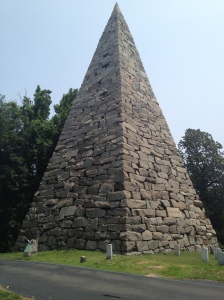Blog Archives
Race, Reconciliation, and Southern Memorialization in Garfield Park
In May, 1919 Indianapolis, Indiana’s “Southern Society”—a group of Indianapolis residents composed primarily of former Southerners—proposed to the Indianapolis Parks Superintendent that a Confederate memorial be moved to one of the city’s parks. The memorial had been erected at Greenlawn Cemetery in 1909 to commemorate Confederate prisoners of war who died in Indianapolis’ Camp Morton. Just over 1600 prisoners had been buried in Greenlawn, but by 1919 the former cemetery had become a modest, poorly maintained city park crowded by factories and railroad lines.
The transplanted Southerners’ interest in preserving the Confederate memorial found a receptive audience in the 20th-century North. While Confederate monuments were being erected throughout the South in the late-19th and early 20th centuries, Civil War monuments were also part of a Northern landscape that aspired to unify the once-divided nation. When the Greenlawn memorial was erected by the federal government in 1909, it was part of a national reconciliation over the legacy of the rebellion that commemorated the foot soldiers of the former Confederacy. The Confederate cause would be largely forgiven by the generation that had grown up after the war, and monuments dotting the South and North alike publicly confirmed a national reconciliation. Yet that forgiveness emerged from a nation committed to Jim Crow segregation, and monuments like the Greenlawn memorial aspired to reconcile and unify the White nation that had waged a civil war a half-century before. A century later the Greenlawn memorial illuminates the ways the Confederate monumental landscape has long distorted Southern heritage and leveraged Confederate mortality in the service of White nationalism. Read the rest of this entry
Memory, Monuments, and Confederate Things: Contesting the 21st-Century Confederacy

Phoenix’s 1961 Memorial to Arizona Confederate Troops (click for larger image, from Visitor7/wikimedia).
In 1961 the United Daughters of the Confederacy presented Phoenix, Arizona with a memorial dedicated to Arizona’s Confederate soldiers. The “Memorial to Arizona Confederate Troops” is a copper ore stonework shaped in the state’s outline that rests atop a pedestal graced by petrified wood. The monument sits on a plaza alongside 29 other memorials at the Arizona State Capitol that range from war memorials to a Ten Commandments monument. The Phoenix Confederate memorial is far removed from the heart of Civil War battlefields and Southern centers, but it is now part of a nationwide debate over the contemporary social and political consequence of Confederate things.

The earliest Confederate monuments were located in cemeteries and included this 1869 90-foot high memorial to the 18,000 Confederates buried in Richmond, Virginia’s Hollywood Cemetery (author’s image).
In the pantheon of Confederate things, statuary is perhaps somewhat distinct from the flags, license plates, and assorted collectibles emblazoned with Confederate symbols. Statues and memorials aspire to make timeless sociohistorical statements and define or create memory, capturing idealized or distorted visions of the war that say as much about their makers and viewers as their subject. Yet as time passes monuments routinely begin to appear aesthetically dated or even reactionary. Viewed from the vantage point of the early 21st century, many Confederate monuments are simply documents of 150 years of shallow fantasies of the South and the Confederacy. Some of those public monuments can possibly foster counter-intuitively reflective and sober discussions about the Civil War, which is a century-and-a-half heritage rather than an objective historical event. However, such discussions risk being circumvented by contemporary Confederate defenders who distort the Confederacy’s history and studiously ignore why an imagined Confederate heritage has become so appealing—if not unsettling–well outside the South.
While it rarely appears in standard Civil War narratives, Arizona can claim a genuine Civil War history. Swaths of southern Arizona and New Mexico territories were claimed by the Confederacy a century before the monument was erected in Phoenix. A secession convention agreed to leave the Union and become the Arizona Republic in 1861, and in February 1862 it became recognized by the Confederacy as the Confederate Territory of Arizona. Confederates fought under the Arizona banner through the war, but the Governor of the Confederate territory retreated to Texas in July, 1862, and for most of the war the military presence in the region was by Union forces.

Dedicated in September, 1867, this Romney, West Virginia monument was one of the nation’s first Confederate memorials (Justin A. Wilcox/wikimedia).
The vanquished Confederacy began to memorialize its cause almost instantly. The town of Cheraw, South Carolina claims to have erected the first Confederate memorial, a cemetery marker erected in June, 1867 (while the town was still occupied by Union forces); a Confederate memorial was dedicated in September, 1867 in Romney, West Virginia. These earliest monuments to the Lost Cause were nearly all cemetery memorials, but the South began busily erecting public monuments to the Confederacy in the late-19th and early 20th-centuries. Scores of statues were placed in former Confederate towns, mostly by a host of ladies’ memorial associations who assumed the care for the Civil War dead and would become the leading proponents of Lost Cause ideology. From its first issues in 1893, Confederate Veteran zealously tracked such monument construction efforts (for example, compare their 1893 monument inventory), and by 1914 they gushed that roughly a thousand public monuments dotted the South: “Year by year with increasing rather than decreasing devotion all over the Southland monuments are rapidly being erected to the heroes who died in the effort of the Confederate States to win a national life.” Read the rest of this entry




